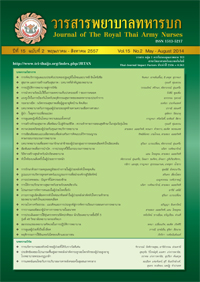ปัจจัยทำนายพฤติกรรมการหลีกเลี่ยงการได้รับควันบุหรี่มือสอง ของผู้ป่วยโรคเรื้อรังในกรุงเทพมหานคร Factors Predicting Second-hand Smoke Avoidance Behavior in Chronic Illness Patients, Bangkok Metropolis
Keywords:
ปัจจัยทำนาย, ควันบุหรี่มือสอง, ผู้ป่วยโรคเรื้อรัง, Predictors, second-hand smoke, Patients with chronic diseasesAbstract
การวิจัยสหสัมพันธ์เชิงทำนายนี้ มีวัตถุประสงค์เพื่อศึกษาพฤติกรรมการหลีกเลี่ยงควันบุหรี่มือสองและปัจจัยทำนาย พฤติกรรมการหลีกเลี่ยงการได้รับควันบุหรี่มือสองในผู้ป่วยโรคเรื้อรัง กรุงเทพมหานคร กรอบแนวคิดในการวิจัยมาจากแบบจำลอง การส่งเสริมสุขภาพของ Pender กลุ่มตัวอย่าง คือ ผู้ป่วยโรคเรื้อรังจำนวน 150 คนที่มารับการรักษาในโรงพยาบาลระดับตติยภูมิ ในกรุงเทพมหานคร คัดเลือกกลุ่มตัวอย่างด้วยการสุ่มแบบเป็นระบบ เครื่องมือที่ใช้ในการวิจัย ได้แก่ แบบสอบถามข้อมูลส่วนบุคคล แบบสอบถามการรับรู้ประโยชน์ของการหลีกเลี่ยงควันบุหรี่มือสอง แบบสอบถามการรับรู้อุปสรรคในการหลีกเลี่ยงควันบุหรี่ มือสอง แบบสอบถามการรับรู้สมรรถนะแห่งตนในการหลีกเลี่ยงควันบุหรี่มือสอง แบบสอบถามแรงสนับสนุนทางสังคมและ แบบสอบถามพฤติกรรมการหลีกเลี่ยงควันบุหรี่มือสอง แบบสอบถามทั้งหมดมีค่าดัชนีความตรงตามเนื้อหา 0.86 ขึ้นไปและ มีค่าสัมประสิทธิ์แอลฟาของครอนบาคระหว่าง .88, .81, .82, .90 และ .92 ตามลำดับ วิเคราะห์ข้อมูลโดยใช้สถิติเชิงพรรณนา สถิติสัมประสิทธิ์สหสัมพันธ์ของเพียร์สันและค่าสัมประสิทธิ์สหสัมพันธ์ถดถอยพหุคูณแบบขั้นตอน ผลการวิจัยพบว่า ผู้ป่วยโรคเรื้อรัง ในกรุงเทพมหานครมีพฤติกรรมการหลีกเลี่ยงควันบุหรี่มือสองในระดับปานกลาง ( = 39.06; SD = 4.69) เพศ, การรับรู้ประโยชน์ ของการหลีกเลี่ยงควันบุหรี่มือสอง, การรับรู้สมรรถนะแห่งตนในการหลีกเลี่ยงควันบุหรี่มือสองและแรงสนับสนุนทางสังคมมีความ สัมพันธ์ทางบวกกับพฤติกรรมการหลีกเลี่ยงการได้รับควันบุหรี่มือสองอย่างมีนัยสำคัญทางสถิติ (p < .05; r = .18, .21, .18, และ .30 ตามลำดับ) นอกจากนี้ยังพบว่าการรับรู้ประโยชน์ของการหลีกเลี่ยงควันบุหรี่มือสองและแรงสนับสนุนทางสังคมเป็นปัจจัย ทำนายที่มีนัยสำคัญทางสถิติ และสามารถร่วมกันพยากรณ์พฤติกรรมการหลีกเลี่ยงการได้รับควันบุหรี่มือสองของผู้ป่วยโรคเรื้อรัง ในกรุงเทพมหานครร้อยละ 16.7 (R2 = 0.167; p < .05)
The purposes of this study were to examine the relationships between gender, level of education, perceived benefits, perceived barriers, perceived self-efficacy in avoiding second hand smoke, social support, and second-hand smoke, and identify the predictors of such variables among patients with chronic illness. The theoretical framework was based on Pender’s Health Promotion Model. A random sample of 150 persons with chronic illness, recruited from three hospitals in Bangkok, participated in this study. Research instruments were self-reported five questionnaires, including the perceived benefits in avoiding second hand smoke, perceived barriers in avoiding second hand smoke, the perceived self-efficacy, social support, and the avoidance behavior of second-hand smoke. All questionnaires have the content validity index values up to 0.86 and the Cronbach's alpha coefficient was .88, .81, .82, .90 and .92 respectively. Data were analyzed using Pearson’s product moment correlation coefficient and multiple regressions. The main results are summarized as follows: Mean score of second-hand smoke avoidance behavior in chronic illness patients was at the medium level ( = 39.06; SD = 4.69). Gender, perceived benefits in avoiding second hand smoke, perceived self-efficacy, and social support were significantly correlated with second-hand smoke avoidance behavior (p < .05; r = .18, .21, .18, and .30 respectively). Furthermore, perceived benefits in avoiding second hand smoke and social support were the significant predictors of second-hand smoke avoidance behavior and together accounted for 16.7 percent of the variance in second-hand smoke avoidance behavior
Downloads
Downloads
How to Cite
Issue
Section
License
บทความหรือข้อคิดเห็นใดใดที่ปรากฏในวารสารพยาบาลทหารบกเป็นวรรณกรรมของผู้เขียน ซึ่งบรรณาธิการหรือสมาคมพยาบาลทหารบก ไม่จำเป็นต้องเห็นด้วย
บทความที่ได้รับการตีพิมพ์เป็นลิขสิทธิ์ของวารสารพยาบาลทหารบก
The ideas and opinions expressed in the Journal of The Royal Thai Army Nurses are those of the authors and not necessarily those
of the editor or Royal Thai Army Nurses Association.






